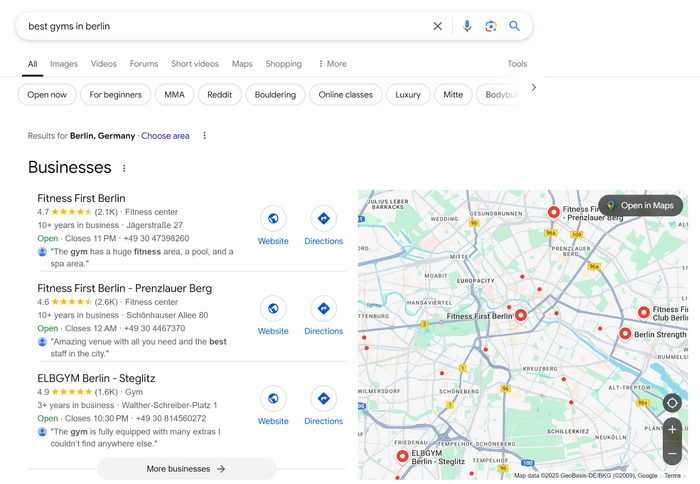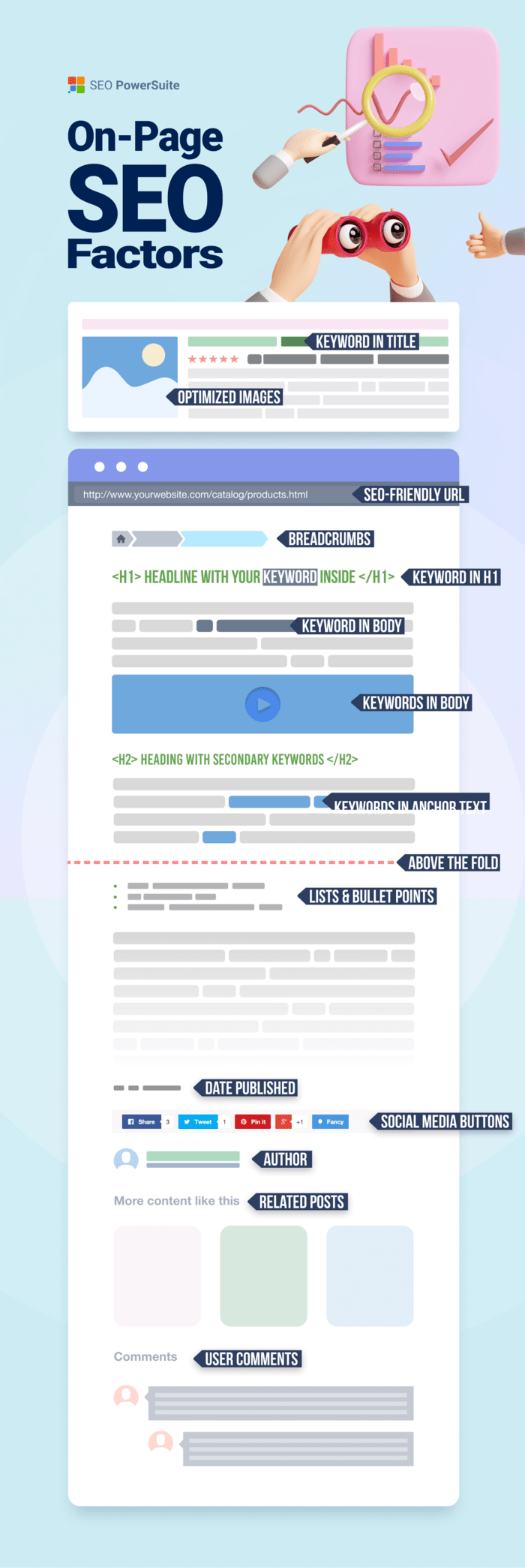SEO for Fitness Gyms: The Complete Guide to Attracting More Members Online

Contents
- 1. Keyword research: targeting the right audience
- 2. Local SEO: getting found in your community
- 3. On-page SEO: optimizing your website for search engines
- 4. Content marketing: engaging & informing potential members
- 5. Link Building: establishing your gym’s online authority
- 6. Technical SEO: enhancing user experience & performance
- 7. Tracking & improving SEO performance
In an era where potential gym members turn to Google before stepping foot in a facility, having a strong online presence is essential. Search Engine Optimization (SEO) for fitness gyms ensures that your gym ranks high in search results, making it easier for people in your area to find and choose your facility over competitors.
A solid SEO strategy not only increases visibility but also improves user experience, drives high-intent traffic, and converts visitors into paying members. Whether you own a small independent gym or a large fitness franchise, investing in SEO can help you grow your membership base significantly.
1. Keyword research: targeting the right audience
Keyword research is the cornerstone of any solid SEO strategy. For gyms, it means understanding how people search for fitness services in your area—and then aligning your content to meet those search intents. Whether you're trying to attract casual gym-goers or hardcore athletes, the right keywords can help your website show up when it matters most.
Why keyword research matters
It’s not just about driving traffic—it’s about driving relevant traffic. You want people who are actively looking for a gym in your area or who are close to making a decision, not just browsing workout ideas. Good keyword targeting ensures that the content you create aligns with the needs and search behavior of your ideal clients.
How to find effective keywords
To uncover the keywords that will get your gym found online, you can use platforms like:
- Google Keyword Planner – Great for basic keyword volume and suggestions.
- RankDots and Rank Tracker – These give you competitive insights, keyword difficulty scores, and search intent breakdowns.
Pro tip
Focus on buyer-intent keywords
These are searches that indicate someone is ready to take action. Examples include:
- “affordable gym memberships near me”
- “best personal trainer for weight loss [city]”
- “sign up for CrossFit class [city]”
Buyer-intent keywords are golden. They usually convert better because the searcher is already considering a specific service or looking to join.
Try adding intent-driven words like:
- “join”
- “sign up”
- “cost”
- “trial”
- “best”
- “near me”
Don’t forget long-tail keywords
Long-tail keywords may not get tens of thousands of searches per month, but they attract highly targeted users who are more likely to convert. These keywords often reflect very specific needs or preferences.
Examples:
- “women-only gym with personal training in [city]”
- “24-hour gym with sauna near [neighborhood]”
- “group HIIT classes for beginners in [city]”
Tip
Bonus: spy on competitor keywords
Want to know what’s already working in your market? Plug your competitors’ websites into Rank Tracker to uncover the keywords they rank for—and which ones are bringing them the most traffic. This can help you identify gaps in your own content or uncover untapped opportunities.
If you're new to keyword research, start small: pick 5–10 keywords that match your services and location, and build dedicated content around each. Over time, as your site gains authority, you can expand into more competitive territory.
2. Local SEO: getting found in your community
Local SEO is one of the most effective ways to drive foot traffic and online visibility for gyms. Whether you're running a boutique fitness studio or a full-scale training facility, appearing in local search results when someone types “gym near me” can directly impact your bottom line. Here's how to boost your gym’s visibility with a smart local SEO strategy:
a) Optimize your Google Business Profile
Most gym-goers look for fitness centers near them, which means local SEO should be your top priority. Google’s local search results often display a “map pack” with business listings, reviews, and contact information. To rank higher in these results, you need to optimize your Google Business Profile (GBP) and website.
- Claim your Google Business Profile at Google Business.
- Fill in all relevant details: name, address, phone number (NAP), website, hours of operation, and services offered.
- Upload high-quality images of your gym, equipment, and classes.
- Collect and respond to customer reviews, as Google prioritizes businesses with frequent, positive feedback.
- Regularly update your profile with posts about promotions, events, and class schedules.
Pro tip
Also, don’t underestimate the power of reviews. According to BrightLocal, 87% of consumers read online reviews for local businesses. Encourage happy members to leave a review after class, and always reply—especially to negative ones—with a helpful, professional tone.
b) Use local keywords on your website
People searching for gyms often use location-based keywords such as:
- “Best gym in [city]”
- “Yoga classes near me”
- “24-hour fitness center in [city]”
Incorporate these keywords in your website’s page titles, headings, meta descriptions, and content to improve rankings.
Create location-specific landing pages if you have multiple branches. For example, “Fitness Training in Austin” and “Group Classes in Dallas” can help you rank for searches in both areas. Each page should have unique content and be optimized for the services available at that location.
Don’t forget to optimize your website’s footer with your NAP (Name, Address, Phone) and add schema markup to help search engines better understand your business location and services.
c) Get listed in local directories
Citations (mentions of your gym’s name, address, and phone number on other websites) help boost your local SEO. Ensure your gym is listed on:
- Yelp
- Facebook Business
- Better Business Bureau (BBB)
- Fitness-specific directories like ClassPass and Mindbody
Why it matters: Consistent citations validate your business information across the web, making it easier for search engines to trust and rank your site. Just make sure your NAP is identical everywhere—it should match what's on your website and Google Business Profile.
Tip
3. On-page SEO: optimizing your website for search engines
Now it’s time to make sure your website is structured so that both users and search engines can easily understand what you're offering. On-page SEO is about making small yet strategic changes to your site’s content and structure that have a big impact on visibility and usability.
Key on-page SEO elements:
a) URL structure
Keep URLs short, readable, and keyword-rich (e.g., yourgym.com/personal-training).
Avoid generic strings like /page?id=123—search engines and users prefer URLs that give context at a glance.
Tip
b) Title tags & meta descriptions
Your title tag is often the first impression people get of your gym in search results. It should:
- Include your primary keyword
- Be under 60 characters to avoid getting cut off
- Clearly communicate your value
Example: Top Gym in Austin | 24/7 Access & Personal Training
Your meta description should:
- Be around 150–160 characters
- Act as a mini ad for your page
- Include a CTA like “Book a free trial session today!”
c) Content & headings
A clean content structure helps users (and Google) quickly understand what your page is about. Use:
- H1 tags only once for the main headline
- H2s and H3s for subtopics and lists
- Bullet points and short paragraphs to improve readability
Tip
d) Image optimization
Images make your website more visually appealing, but they can also impact your SEO if not optimized correctly.
- Compress images to reduce load times without sacrificing quality
- Always add descriptive alt text (e.g., “Group strength training class at ABC Fitness”)
- Rename files before uploading (e.g., bootcamp-class-brooklyn.jpg instead of IMG_9382.jpg)
Tip
4. Content marketing: engaging & informing potential members
Think of content marketing as your digital handshake—it builds trust, answers questions, and keeps your gym top-of-mind even before someone walks through your doors. It also provides more content for Google to index, which means more chances to rank.
Types of content to create:
- Blog posts: These are great for covering both evergreen topics (“How Strength Training Boosts Metabolism”) and seasonal content (“Spring Fitness Challenge: What to Know”).
- FAQ pages: Go beyond the basics. Add real customer queries you’ve heard over the phone or in DMs. It’s a subtle but powerful way to improve SEO while removing barriers to conversion.
- Member success stories: Showcase diverse body types, fitness goals, and backgrounds to attract a wider audience and build emotional connection.
- Workout guides & videos: Create quick how-tos like “5-Minute Core Burn” or “Stretching for Desk Workers.” These can rank well on both Google and YouTube.
- Event updates: Use these pages to promote new classes, themed sessions (like “Zumba Glow Night”), or seasonal promos.
Content best practices:
- Consistency > frequency: Even 1–2 well-researched posts a month can make a difference if they’re strategic and optimized.
- Internal linking: Always link to related classes, services, or success stories to keep visitors browsing and boost SEO.
- Repurpose smartly: Turn long blog posts into Instagram carousels, infographics, or short videos for maximum reach without doubling your workload.
5. Link Building: establishing your gym’s online authority
Backlinks from trusted websites act like votes of confidence in the eyes of Google. The more quality links pointing to your gym’s site, the more authority (and ranking potential) your pages will gain.
How to get quality backlinks:
Guest blogging
Pitch topics like “How to Start Working Out After 40” to local wellness blogs, parenting sites, or lifestyle publications. Include a natural link back to your site in the bio or within the content.
Local partnerships
Team up with local massage therapists, chiropractors, or healthy cafés. Cross-promote each other’s content and create “wellness bundles” or co-branded events.
Press releases
Launch a press release when you open a new location, win an award, or introduce a unique program (like youth fitness or prenatal training). Then you can distribute them via local news outlets and industry-specific publications.
Sponsorships & events
Host or sponsor 5Ks, charity yoga events, or health fairs. These often result in backlinks from event organizers, local blogs, and media.
Social media sharing
Create content that's link-worthy—think infographics, transformation stories, or expert Q&As—and encourage members and partners to share it on their websites or blogs (not just social).
6. Technical SEO: enhancing user experience & performance
Search engines are prioritizing user experience more than ever. If your website loads slowly, isn’t mobile-friendly, or has errors, it’s going to hurt your rankings—even if your content is top-notch.
Technical SEO must-haves:
Mobile optimization
With the majority of gym searches happening on mobile, your site must be responsive. Test it across different devices and screen sizes.
Page speed
Use tools like Google PageSpeed Insights or GTmetrix to identify what’s slowing you down (like uncompressed images or bulky scripts). Keep in mind that fast-loading sites retain more visitors and rank higher.
Secure website (HTTPS)
SSL isn’t just a “nice to have”—it’s a ranking factor and a trust signal. Make sure your hosting provider includes a security certificate and that all pages are served over HTTPS.
Fix broken links & errors
Use tools like WebSite Auditor to crawl your site for 404 errors, redirect chains, or duplicate content issues.
Submit an XML sitemap
This helps Google index your pages efficiently. You can generate one using Yoast (WordPress) or WebSite Auditor, then submit it through Google Search Console.
Tip
7. Tracking & improving SEO performance
SEO isn’t a one-and-done job—it’s a continuous cycle of tracking, learning, and optimizing. By consistently reviewing your performance data, you can identify what’s working and where to improve.
Best tools to track SEO progress:
- Google Analytics – Understand how people interact with your site and where they’re coming from.
- Google Search Console – Monitor keyword rankings, click-through rates (CTR), and indexation issues.
- SEO PowerSuite – Get in-depth competitor insights, backlink tracking, and keyword movement data.
Key metrics to monitor:
- Organic traffic: Look for consistent growth over time, especially for local landing pages.
- Keyword rankings: Focus on both average position and impressions to see what’s gaining visibility.
- Bounce rate & dwell time: High bounce rates may mean irrelevant content or poor UX—dive deeper into those pages.
- Conversion rate: Tie your SEO performance to business outcomes—form fills, sign-ups, free trial bookings, etc.
- Review score & volume: A boost in positive reviews often correlates with increased clicks and trust.
Next steps: Set up monthly reporting dashboards (e.g., in Looker Studio or via Google Analytics alerts) so you’re not flying blind. SEO is a long game, but regular tuning ensures you stay ahead of your competitors.
Conclusion
SEO is one of the most powerful marketing strategies for increasing gym memberships and standing out from competitors. By optimizing local SEO, keywords, content, link-building, and technical SEO, your gym can consistently rank higher in search results and attract more potential members.
Start implementing these SEO tactics today, and watch your gym grow in visibility, engagement, and membership sign-ups.






